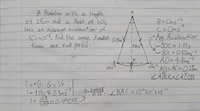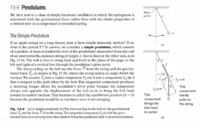Inertia_Squared
Junior Member
- Joined
- May 24, 2019
- Messages
- 54
I'm trying to find a way to prove with the information given (all said information is on image attached) the value of the angle a pendulum makes from a full period i.e. the 2x angle that it is released from (friction is not being accounted for here), and although I think I may have done it, I'm not sure how valid it is because I'm using different types of units, which is typically a big no-no. I attempted to rectify this by converting the arc-length into a length (I had two values for the arc-length; the average acceleration and the period in seconds) however I'm not sure if that is a valid way to go about it. I've formatted my working as a textbook-style question but I would like to be perfectly clear that its entirely possible for this to have no real solution, although I'm pretty sure that even if this method doesn't work there would be another that does.
Long story short I'm looking for someone to check my working and to see if it's correct, and if not maybe show me a method I could use to solve it? Either way, Thanks in advance!
P.S. Compared to what I'm doing at school (Y11 Ext 1 Maths) I know this is rather simple, however, I'm using this as a double-check an idea I have for an assignment. The current Q I'm on is to make an appropriate graphical model of the length and period of a pendulum, but since its one of the earlier and easier bits, I wanted to go the extra mile and do a real in-depth analysis of its behaviour (its holidays and I have some time to kill so I thought why not). Since its extra work and won't be marked on it I'm 99% sure its be fine to post this here; however I do believe that doing that little bit extra would help me to get a better understanding of the nature of the pendulum, which is why I want to check it here, as doing extra for a better understanding is great, but I don't want to do it wrong and have it end up being harmful in the end!

Long story short I'm looking for someone to check my working and to see if it's correct, and if not maybe show me a method I could use to solve it? Either way, Thanks in advance!
P.S. Compared to what I'm doing at school (Y11 Ext 1 Maths) I know this is rather simple, however, I'm using this as a double-check an idea I have for an assignment. The current Q I'm on is to make an appropriate graphical model of the length and period of a pendulum, but since its one of the earlier and easier bits, I wanted to go the extra mile and do a real in-depth analysis of its behaviour (its holidays and I have some time to kill so I thought why not). Since its extra work and won't be marked on it I'm 99% sure its be fine to post this here; however I do believe that doing that little bit extra would help me to get a better understanding of the nature of the pendulum, which is why I want to check it here, as doing extra for a better understanding is great, but I don't want to do it wrong and have it end up being harmful in the end!


